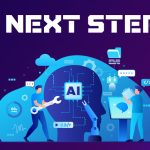AI can stand for both Automated Intelligence and Artificial Intelligence, and it’s important to understand the distinction between the two.
Imagine AI as a super-smart robot friend! AI, or Artificial Intelligence, is when computers learn to think and make decisions like humans. It’s like teaching your robot buddy to recognize colors, play games, or even understand when you’re happy or sad. AI helps machines learn from experiences and become good at tasks without being told exactly what to do. It’s like having a friend who learns and gets better every time you play together. So, AI is like magic computer brains that make our machines and robots super clever and helpful!
There seems to be a lot of confusion among professionals and laypeople regarding the difference and functionality of these two concepts.
Automated Intelligence has been in existence for quite some time. At its core, it involves predicting actions based on patterns. A typical example of Automated Intelligence is a spam filter. As a user, when you mark five emails as spam, the spam filter utilizes those marked emails as a reference to determine which other emails are likely to be spam. Future emails are then compared against the reference template and variations of the templated emails, allowing the system to learn and improve. If the system makes a mistake, the user can mark an incorrectly classified email as “good,” and the algorithm will adjust accordingly.
Automated Intelligence is task-oriented and driven, providing significant assistance in many cases. Grammar checkers are another example of Automated Intelligence. They analyze the context of words and learn the user’s patterns. While some grammar rules are universal, such as the distinction between “their” and “there,” other rules are more subjective, and a reliable grammar checker learns the user’s preferred style through their writing.
This form of Automated Intelligence is focused on specific tasks and requires human management, ultimately serving to support humans in their activities.
On the other hand, Artificial Intelligence is an entirely different concept, and it is neither truly artificial nor intelligent.
As humans increasingly document our conversations digitally, we have amassed an enormous database of raw information. Platforms like CHAT GPT were partially trained on Reddit. Consider the content on Facebook, emails, websites, and all the digital content created by humans over the past three decades. This vast pool of information represents a wealth of human interactions and reactions. Some of it is marketing-focused, legal-focused, or politically-focused, while other content is intended to evoke laughter or anger. It encompasses the entire spectrum of human emotions. Think of this extensive collection of data as a massive database.
The challenge with such a database is that not all entries carry the same weight or significance in our minds. For example, articles about constructing a bomb are treated with the same importance as articles about Mother Teresa. However, as humans, we inherently value the articles about Mother Teresa’s charitable work more than instructions on building a bomb. In a large database, our subjective prioritization cannot be easily measured, as all data points are treated equally.
Artificial Intelligence goes beyond the capabilities of Automated Intelligence, but the key differentiating factor lies in the process of “training.”
Training AI developers often highlight the complexity and elegance of the training process. At its core, training involves inputting data to allow the system to perceive and comprehend patterns. Referring back to the previous example of marking spam, this process trains the system to identify spam. In modern systems, training involves reviewing vast portions of the human-created content database.
Modern CPUs contain billions of transistors and possess tremendous processing power. AI training utilizes this processing capability, especially through parallel processing, to categorize, process, and learn the patterns of human communication. Once the system has absorbed and comprehended the patterns, it can respond with the most probable answer based on what it has learned and calculated from the review data (the human database). This extensive review process is commonly referred to as a “large model.” The “training” involves categorizing and processing each question and response.
I hope this clarifies the distinction between Automated Intelligence and Artificial Intelligence, as well as sheds light on the training process in AI systems.
Please let us know if you have any further questions or if there’s anything else we can assist you with.






